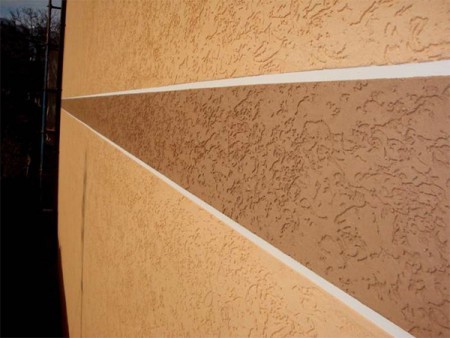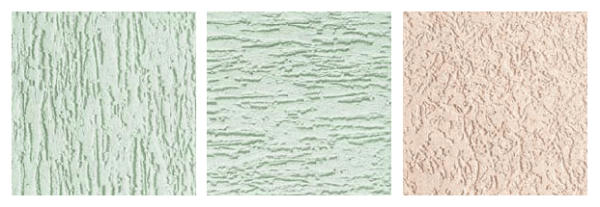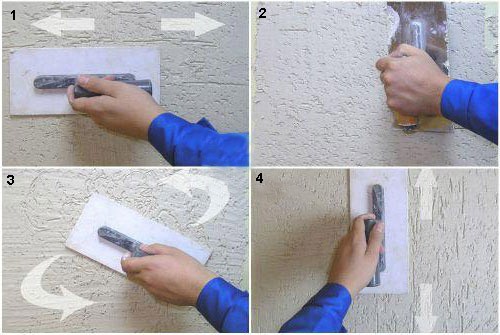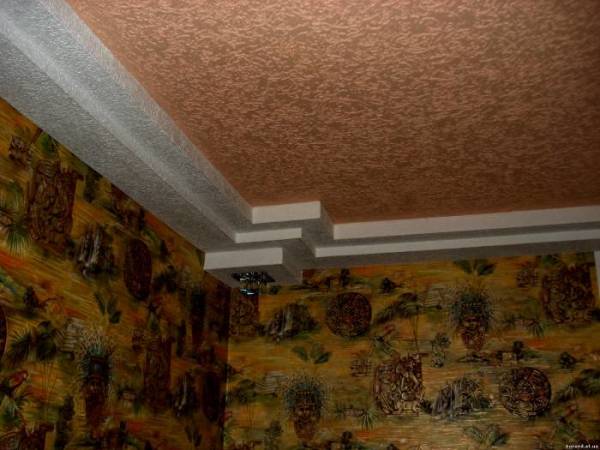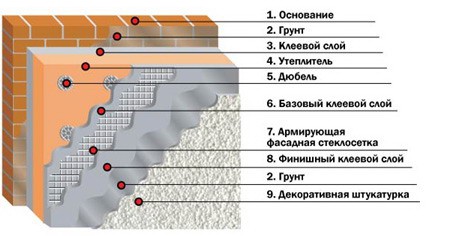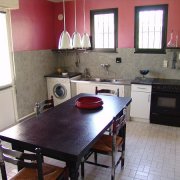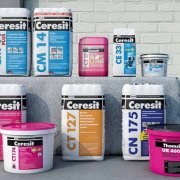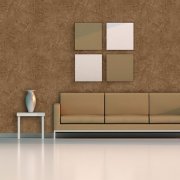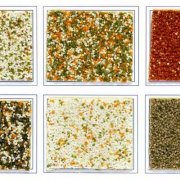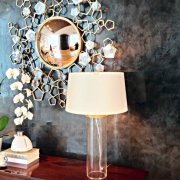Plaster Bark beetle: application options
Structural plaster "Bark beetle" is intended for painting, decoration of premises and exterior facades. The name of the material was due to its drawing, created on the surface after its application and resembling traces from the actions of the bark beetle in wood. What is bark beetle plaster, its composition and method of application will be described in the article.
The content of the article
Material Features
Finishing bark beetle plaster is produced in two types:
- Acrylic (see Acrylic plaster for the facade: how to use). It goes on sale ready for use in a special container.
- Gypsum based. Consists of a mixture of dry components, packaged in bags.
Bark beetle ceresit plaster or its other type is a composite material containing small pebbles. Each manufacturer has his own recipe for the manufacture of the mixture, but usually granules are marble or mineral chips, the sizes of which range from 0, 1 - 3.5 millimeters.
Material Advantages:
- As part of the decorative bark beetle coating, sand replaces a special mineral filler and polymer components. This gives the finished composition a high viscosity, which increases the adhesion of the material to the surfaces of the walls to be finished.
- Decorative plaster Knauf "Bark beetle" is environmentally friendly, does not emit toxins, which can negatively affect human health.
- Light weight. This greatly reduces the load on the walls being trimmed.
- Withstands large fluctuations in temperature. This limit is from (+ 60 ° С) to (-60 ° С), it is not affected by ultraviolet radiation, is fire-resistant, it is not afraid of damp weather and strong wind.
- Excellent vapor permeability. After application, such plaster provides good ventilation of the walls, their surface “breathes”. This prevents the formation of fungus on the walls, which means it increases the life of the building. The surface acquires resistance to liquid solutions and a low concentration of chemicals, it is quite easy to wash with water and does not deteriorate from precipitation.
- The resulting coating is resistant to mechanical stress., the plaster can be cleaned with a vacuum cleaner, wiped with a soft sponge, it withstands gentle shock.
- Has good staining ability.. The main color of the coating is white, and the desired shade can be obtained using special pigment dyes, or by painting the wall, after using the Bark beetle plaster, with a water-based paint in which coloring elements are added (see Painting bark beetle plaster - all ways).
- Acceptable price, which can be further reduced by applying the plaster with your own hands.
Features of using bark beetle plaster
The above characteristics of the decorative mixture allow it to be used widely enough for interior and exterior decoration.
Only the owner’s desire depends on the resulting picture. To do this, you should first see what bark beetle plaster is. The video tells in detail about all its types and characteristics.
The pattern on the surface is determined by the nature of the movements of the tool when applying the coating, and its subsequent grouting. In this case, the movement of the spatula on the treated surface can be, as shown in the photo:
- Fig. 1 - horizontally.
- Fig. 2 - scarring.
- Fig. 3 - in circular motions.
- Fig. 4 - vertically.
- Along or across.
- The waves.
- The chaotic arrangement of the image.
- You can also depict wall painting.
Tip: The above examples of applying plaster are just some of the techniques for decorating walls. For additional effects, the finished surfaces should be painted.
Before starting surface finishing operations, the right material to use is selected. Many manufacturers produce bark beetle plaster, and each has its own original recipe and composition.
Tip: When choosing a composition, you should pay attention to the type and granularity of the plaster. Granularity determines the depth and width of the grooves that are obtained when creating the image.
Besides:
- The granularity of the decorative bark beetle plaster has an effect on the consumption of the material. With a granule size of 3.5 millimeters, consumption increases.
- Select material type “Bark beetle”:
- ready-made plaster for use. It is more convenient to work with such a composition, but its cost is higher. The mixture uses synthetic fillers: silicone, acrylic;
- dry powder. With proper preparation of the composition, the mineral "Bark beetle" is practically not inferior to the finished mixture.
A decorative Bark beetle should be applied on surfaces that have good adhesion or adhesion to them.
The mixture should not be applied to:
- Glass.
- Metal walls of the garage.
Without any problems, the material will lie on the surface of:
- A stone.
- The brick.
- Concrete.
- Drywall.
Tip: “Bark beetle” Knauf plaster is used for final finishing. It should not be used for sealing on the surfaces of cracks or pits.
Technology of applying plaster "Bark beetle" simple, this can be seen from the video tutorial for the article. In this case, it is necessary to observe some rules and carefully implement them.
How to prepare for plastering "Bark beetle"
To work, you will need:
- Plaster "Bark beetle".
- Capacity.
- Different width spatulas.
- Plastic grater.
- Electric drill with nozzle “mixer”.
Before wall decoration with decorative plaster The bark beetle should have a well prepared surface.
Her need:
- Clean it from dust.
- Remove greasy stains.
- Remove dirt and mold.
- Decorative coating can not be applied to the wall, so as not to plaster it first. Before the bark beetle, the surface should be well prepared, putty filled all pits and cracks.
- The plane should turn out smooth, irregularities are allowed no more than the size of the grains of the plaster.
- A special primer is applied on the base of the wall, in the same color as the plaster. Such material in the future will provide good adhesion, and will not be visible through the bulk.
- After the primer dries, about five hours, the plaster is applied.
Tip: When carrying out the process, you should use material from one manufacturer, which will give the best result when finishing the surface.
There are special finishes for specific brands:
- The decorative bark beetle ceresit plaster when preparing the surface requires applying a CT16 primer.
- When plastering the outer surface, it should not be primed.
To prepare the composition of the dry mixture, you must follow the existing instructions.
General rules are:
- Stucco slowly pours out into the water, but you can not do the opposite.
- The water temperature is taken at about 20 ° C.
- With a mixer or electric drill with a nozzle, the resulting mass mixes well.
- Upon reaching the desired consistency of the composition, it settles for several minutes and mixes again.
Tip: Each type of plaster in diluted condition, has its own expiration date, which is indicated on the package. You cannot breed it by adding water. To prepare the solution you need only as much as you need to work for the specified time.
How is bark beetle applied?
According to the technology, the application of Bark beetle plaster involves two stages:
- Application of material.
- Creation of a textured surface on it.
Work Instructions:
- You need to start from the lower right corner, the mixture is superimposed on the wall and gradually leveled off the surface from the floor up. When applying the mixture, the bark beetle is stretched to form a layer whose thickness is equal to the size of the granules that make up the composition.
- The thickness of the layer is determined by the appearance on the surface of scratches or grooves.
- A spatula or grater for applying the mixture is placed at an angle of 60 ° to the wall surface, and then stretches from the bottom up until the desired layer thickness is obtained.
- The plaster dries slightly.
- Performed by the formation of the invoice.
When forming a decorative layer, the textured surface is created with a plastic trowel or grater. The tool is applied to the plastered surface with the entire plane and is pressed a little.
The movement of the tool determines which pattern appears on the finished coating:
- Circular uneven movements of the grater make it possible to obtain a classic image obtained from a gnawed wood bug. By lightly pressing the tool, circular or arched movements in different directions are performed.
- The image "travertine" is obtained when performing short jerky movements. The tool can be moved in any direction to get an imitation of the uneven surface of the stone.
- The cork pattern is made using a polystyrene foam trowel. At the same time, movements are made intensively, in a circle, moving the tool in only one direction. In this case, circular movements should be performed with a small radius.
- The woven surface can be imitated by cruciform movements of the grater. When moving it from the bottom up, average speed and a long pull are needed, and horizontal strokes should be applied with short energetic strokes.
- The image “rain” is obtained by making long continuous movements along the diagonal.
- A complicated way to apply the “world map” coating. For its formation, the bark beetle is applied in a single layer, and then rubbed in any way. After drying, another layer is made with separate strokes of the mixture in different directions. It is smoothed out by the Venetian trowel.
After the formation of the pattern, it is necessary to carefully grind the joints, and smooth the entire surface of the wall without pressing until the mixture has frozen. If during mixing, the mixture was not tinted, the wall after drying can be painted for three days for silicate paints, and for acrylic paints - two weeks.
The video in this article will tell you in more detail about all the features of Bark beetle plaster.
